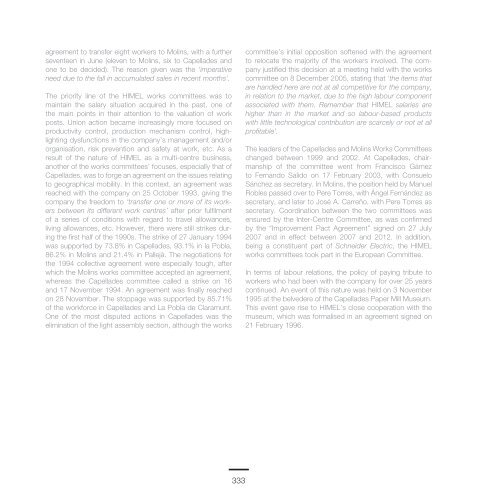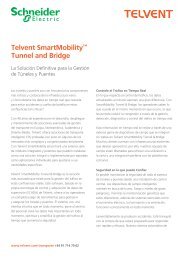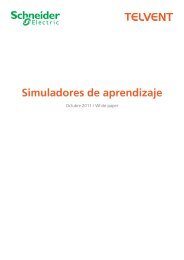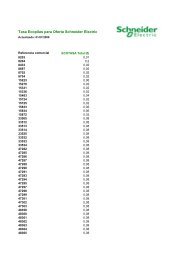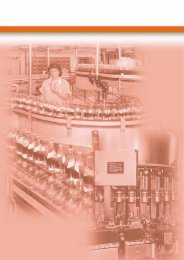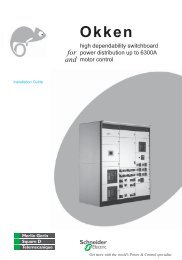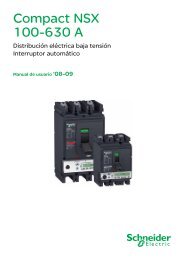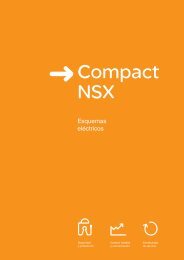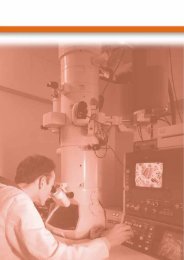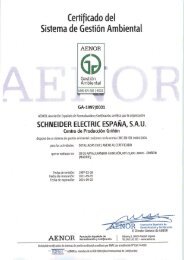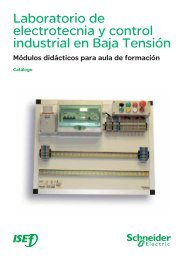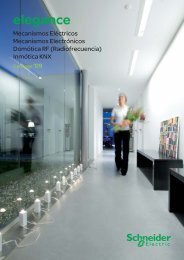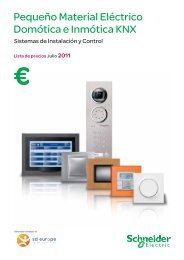Untitled - Schneider Electric
Untitled - Schneider Electric
Untitled - Schneider Electric
Create successful ePaper yourself
Turn your PDF publications into a flip-book with our unique Google optimized e-Paper software.
agreement to transfer eight workers to Molins, with a furtherseventeen in June (eleven to Molins, six to Capellades andone to be decided). The reason given was the ‘imperativeneed due to the fall in accumulated sales in recent months’.The priority line of the HIMEL works committees was tomaintain the salary situation acquired in the past, one ofthe main points in their attention to the valuation of workposts. Union action became increasingly more focused onproductivity control, production mechanism control, highlightingdysfunctions in the company’s management and/ororganisation, risk prevention and safety at work, etc. As aresult of the nature of HIMEL as a multi-centre business,another of the works committees’ focuses, especially that ofCapellades, was to forge an agreement on the issues relatingto geographical mobility. In this context, an agreement wasreached with the company on 25 October 1993, giving thecompany the freedom to ‘transfer one or more of its workersbetween its different work centres’ after prior fulfilmentof a series of conditions with regard to travel allowances,living allowances, etc. However, there were still strikes duringthe first half of the 1990s. The strike of 27 January 1994was supported by 73.8% in Capellades, 93.1% in la Pobla,86.2% in Molins and 21.4% in Pallejà. The negotiations forthe 1994 collective agreement were especially tough, afterwhich the Molins works committee accepted an agreement,whereas the Capellades committee called a strike on 16and 17 November 1994. An agreement was finally reachedon 28 November. The stoppage was supported by 85.71%of the workforce in Capellades and La Pobla de Claramunt.One of the most disputed actions in Capellades was theelimination of the light assembly section, although the workscommittee’s initial opposition softened with the agreementto relocate the majority of the workers involved. The companyjustified this decision at a meeting held with the workscommittee on 8 December 2005, stating that ‘the items thatare handled here are not at all competitive for the company,in relation to the market, due to the high labour componentassociated with them. Remember that HIMEL salaries arehigher than in the market and so labour-based productswith little technological contribution are scarcely or not at allprofitable’.The leaders of the Capellades and Molins Works Committeeschanged between 1999 and 2002. At Capellades, chairmanshipof the committee went from Francisco Gámezto Fernando Salido on 17 February 2003, with ConsueloSánchez as secretary. In Molins, the position held by ManuelRobles passed over to Pere Torres, with Ángel Fernández assecretary, and later to José A. Carreño, with Pere Torres assecretary. Coordination between the two committees wasensured by the Inter-Centre Committee, as was confirmedby the “Improvement Pact Agreement” signed on 27 July2007 and in effect between 2007 and 2012. In addition,being a constituent part of <strong>Schneider</strong> <strong>Electric</strong>, the HIMELworks committees took part in the European Committee.In terms of labour relations, the policy of paying tribute toworkers who had been with the company for over 25 yearscontinued. An event of this nature was held on 3 November1995 at the belvedere of the Capellades Paper Mill Museum.This event gave rise to HIMEL’s close cooperation with themuseum, which was formalised in an agreement signed on21 February 1996.333


